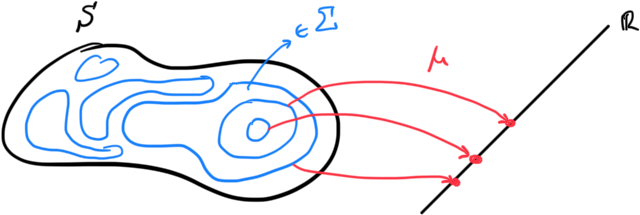Functional Analysis
Some notes on functional analysis for PDEs. The main aim of this is to construc a framework to prove things about dissipative systems and their symmetries but in the language of functional analysis and measure theory.
Measures
Let’s start by studying measures. In order to do this, we need something to measure. So we start with a set
Definition: Given a set
Corollary: This implies that
Definition: Given
Now to map the a actual subsets to some field like the real numbers. What we construct is a measure which works like the picture below.

Definition: Given a measurable space
- Given a sequence
Also the pair
Notice that measures are designed to steal the intuition from volumes of a set. Especially the last property about the additivity of the union is like taking a volume, chopping it up in little parts where the sum of their volume is the original volume.
Notice that for now on we will be using
The Lebesgue measure
The Lebesgue measure is a way to define volumes in
Definition: Let
Then we can define an open interval
With this we can now measure the volumes of intervals in

Definition: Given a subset
This forms a measure, and an interesting measurable space over
Corollary: These sets form a
Function Spaces
Given two sets we can define a set of all the functions from one to the other. However, there is no reason for this set to have any further structure, since we can’t do any operations on the functions. It is the codomain that allows us to operate on the functions. If operations are defined there, we can steal them and give a more interesting structure to the set of all functions! We will explore this here.
Definition: Given two sets
The reason is that this set generalizes powers of sets. Take a look at this to find out why, it’s cool!
Now I would like to give some structure on
Definition: A normed vector space
Examples: Common examples are
Having the tool of Banach spaces it is time to give more structure to our set of functions.
Corollary: if
defining an addition and scalar multiplication on
Note that these functions spaces are not necesssarily finite dimensional. In fact most often they are not, and that is ok.
Measuring Function Spaces
To measure function spaces we need a metric. It would be nice, however, to induce it from some predefined measure on the domain of the functions. Here we will introduce the notion of the Lebesgue integral that allows us to create a map from functions to numbers, and we will then use it to create a metric on function spaces. Here we will actually define the Bohner Integral which is an extension of the Lebesgue integral for Banach valued functions. But since the extension is trivial we will still call it the Lebesgue integral :)
Integration
Definition: Let
We can construct functions in
where
Quick Sidenote: Reading a functional analysis textbook someone might come across the distasteful and almost sacrilegious term that something is true for “almost every” point
. Believe it or not this has a precise definition smh. here it is.Given a measure space
a property that holds for almost everyis such that if it is not true for a subsetthen there exists a larger subsetin the-algebra such thatand. In other words it might not be true for some points, but all these points have measureso we don’t care about them. Just a heads up
Now that we have simple functions we can start integrating them
Definition: A simple function
To define the integral for non-simple functions we need to figure out a way to know which ones we can take the integral of.
Definition: A function
Notice the similarity of this definition to continuity in a metric space.
Notice that this uses the for almost all terminology, so it doesn’t have to hold for subsets of measure zero. Which allows discontinuities
Definition: Given a measurable function
where the integral is the ordinary Lebesgue integral of
Definition: Given an integrable function
Corollary: The sequence
Spaces of Integrable Functions
We have now defined an integral for Banach valued functions. As a result, we can go ahead and define spaces of integrable functions. Then we will add a Hilbert space structure on them in order to talk about operators and stuff!
Definition: An inner product space
Corollary: A Hilbert space
Corollarollary: A Hilbert space is also a Banach space
Now that we have this out of the way, let’s put it in the back of our minds, and construct the sets of itnegrable functions
Definition: We say a function
Corollary: For
Note that the product of
Theorem: (Bochner Theorem) Given a measurable function
and
Operators on Such Hilbert Spaces
Now we have a way of constructing Hilbert spaces using Banach valued functions and we can use these tools in order to study operators. We will represent differential equations as operators from one Hilbert Space to another. In this section we aim to study some properties of the operators to use in the upcming ones.
Definition: Let
Let’s classify them a bit more
Definition: A linear operator
-
Bounded iff
-
Continuous iff the preimage of every open set in
-
Closed iff whenever
Theorem: A bounded linear operator is continious, and a closed linear operator is bounded.
Definition: Given a Hilbert space
An operator where